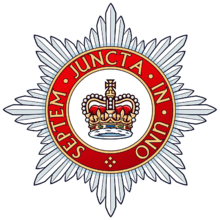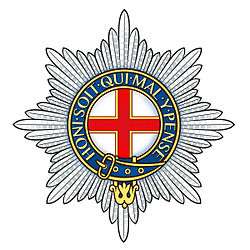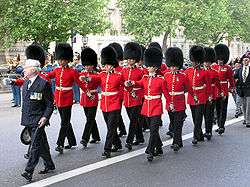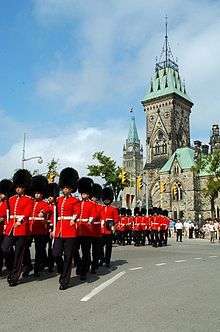Foot Guards
In some militaries, foot guards are senior infantry regiments.
Australia
The Federation Guard is a tri-service Australian ceremonial unit that performs similar functions to the five British and two Canadian regiments of foot guards.
British Army
Overview




The Foot Guards are the Regular Infantry regiments of the Household Division of the British Army. There have been six active regiments of foot guards and one reserve regiment, five of which still exist. The Royal Guards Reserve Regiment was a reserve[1] formation of the Household Brigade in existence from 1900 to 1901. The Machine Gun Guards, which was formed during the First World War, was disbanded in 1920:
- Grenadier Guards
- Coldstream Guards
- Scots Guards
- Irish Guards
- Welsh Guards
- Guards Machine Gun Regiment (Disbanded)
- Royal Guards Reserve Regiment
While these regiments have other distinguishing features, a simple method of distinguishing members of the different Guards units by their appearance is by the spacing of buttons on the tunic. The ascending number of buttons also indicates the order in which the regiments were formed, although the 1st Regiment of Foot Guards, an ancestor of the Grenadier Guards, is younger than the regiment that now takes the name of the Coldstream Guards; the oldest continuously serving regiment in the regular British Army (there are older regiments in the Army Reserve). There are various other distinguishing features of the uniforms of the regiments, such as the colour of the plume, which side it is worn on the bearskin, the collar badge and the shoulder badge. When all five regiments parade together, they are in the order of Grenadier Guards on the right flank, then Scots Guards, Welsh Guards, Irish Guards and Coldstream Guards on the left flank. This is because although the Coldstream are ranked second in seniority, their motto is 'Nulli Secundus' ('Second to None').
The five regiments of Foot Guards, lined up as they parade

Units of the Foot Guards
- Grenadier Guards (White plumes on left of bearskin; grenade badge on collar; evenly spaced tunic buttons)
- 1st Battalion, Grenadier Guards
- Nijmegen Company, Grenadier Guards
- Coldstream Guards (Red plumes on right of bearskin; Garter star badge on collar; paired tunic buttons)
- 1st Battalion, Coldstream Guards
- No 7 Company, Coldstream Guards
- Scots Guards (No plumes; thistle badge on collar; tunic buttons in threes)
- 1st Battalion, Scots Guards
- F Company, Scots Guards
- Irish Guards (Blue plumes on right of bearskin; shamrock badge on collar; tunic buttons in fours)
- 1st Battalion, Irish Guards
- Welsh Guards (White-green-white plumes on left of bearskin; leek badge on collar; tunic buttons in fives)
- 1st Battalion, Welsh Guards
The first three regiments each have a separate incremental company, which keep custody of the colours and traditions of the currently dormant 2nd Battalions. These companies perform ceremonial and security duties in London.

The Foot Guards have a role as the primary garrison for the capital, for the military security of the Sovereign, and for ceremonial duties in London and occasionally elsewhere. Two battalions are appointed for public duties, with a third from a line infantry regiment since 1996 (and occasionally previous to that year). These provide the Queen's Guard, the Tower of London Guard, and sometimes also the Windsor Castle Guard. The Guards Battalions on Public Duties are located in barracks close to Buckingham Palace for them to be able to reach the Palace very quickly in an emergency. In central London, a battalion is based at Wellington Barracks, Westminster, about 300 yards from Buckingham Palace. However, as of 2010, the independent incremental companies of the Grenadier and Coldstream Guards (all on permanent public duties) have been moved from Chelsea Barracks to the Royal Artillery Barracks in Woolwich. While F Company, Scots Guards, are now permanently based at Wellington Barracks alongside the resident infantry battalion.
The Guards Battalion stationed at Windsor generally provides the Windsor Castle Guard. The Windsor battalion is at Victoria Barracks, a quarter of a mile south of the Castle.
The Guards Division received a new battalion following the restructuring of the army in 2004, when the London Regiment became the first ever Territorial Army Guards unit.
The Royal Guards Reserve Regiment was in existence during the Second Boer War from 1900 to 1901.
The Guards Machine Gun Regiment was raised for service during the First World War. Initially, each brigade of the Guards Division had a machine gun company attached. In 1917, these companies were regimented to form a battalion. Further battalions were formed by conversion of the Household Cavalry regiments, and King George V ordered that the regiment be classified as the Sixth Regiment of Foot Guards, or Machine Gun Guards. However, it was disbanded in 1920.
Before the Second World War, Guards recruits were required to be at least 5 feet 10 inches tall, they initially enlisted for seven years with the colours and a further five years with the reserve or four years and eight years. They trained at the Guards' Depot in Caterham, Surrey.[2]
In the future, the Foot Guards will serve in the ceremonial role, and the Reaction and Adaptable Forces.[3]
Lance-sergeants within Foot Guards
In the Foot Guards, all corporals are automatically appointed as lance-sergeants on their promotion; lance-sergeants perform the same duties as corporals in other regiments and are not acting sergeants, despite their name.
The appointment of lance-sergeant originated in the British Army and Royal Marines, as it could be removed by the soldier's commanding officer, unlike a full sergeant, who could only be demoted by court martial. Lance-sergeants first appeared in the nineteenth century, but[4] the practice was abolished in 1946, except in the Foot Guards and the Honourable Artillery Company. Both sergeants and lance-sergeants wear three rank chevrons, but in full dress, Foot Guards lance-sergeants are distinguished from full sergeants by their white chevrons and button loops (full sergeants wearing gold along with a red sash over the right shoulder).
Order of precedence
| Preceded by Royal Corps of Signals |
Order of precedence | Succeeded by Line Infantry and Rifles |
Canadian Army
Two foot guards regiments exist in the Canadian Army, the Governor General's Foot Guards and the Canadian Grenadier Guards. Her Majesty's Regiment of Canadian Guards was a regiment of the regular army, with four battalions, but was reduced to nil strength in 1968. Its Colours are in the safekeeping of the Governor General of Canada at Rideau Hall should it be desired to standup the Regiment again. Although the Governor General's Foot Guards has its buttons in pairs, compared to the single buttons of the Canadian Grenadier Guards, it is the more senior regiment; it is affiliated to the Coldstream Guards, and so wears a similar uniform.
| Regiment | Plume | Plume colour | Button spacing | Collar badge | Shoulder badge |
|---|---|---|---|---|---|
| British Army | |||||
| Grenadier Guards | Left | White | Singly | Grenade | Royal Cypher |
| Coldstream Guards | Right | Scarlet | Pairs | Garter Star | Rose |
| Scots Guards | None | N/A | Threes | Thistle | Thistle Star |
| Irish Guards | Right | Blue | Fours | Shamrock | St Patrick Star |
| Welsh Guards | Left | White-Green-White | Fives | Leek | Leek |
| Canadian Army | |||||
| Governor General's Foot Guards | Left | Scarlet | Pairs | GGFG Guards Star | Maple Leaf |
| Canadian Grenadier Guards | Left | White | Singly | Grenade | Grenade |
| Canadian Guards (reduced to nil strength) | Left | Red & White | Singly | Crowned Maple Branch | Crowned Maple Branch |
Finland
The Guard Jaeger Regiment (Finnish: Kaartin Jääkärirykmentti, Swedish: Gardesjägarregementet) is a Finnish Army unit located in Santahamina, an island district of Helsinki. The regiment trains Guard jaegers for fighting in an urban environment. The Military Police Company of the Guard Jaeger Regiment provides the ceremonial Guard of Honor for the President of Finland.
German Empire
There were five regiments of Foot Guards (German: Garde-Regimenten zu Fuß) in the Royal Prussian Army until 1919.
- 1st Foot Guards, formed in 1806.
- 2nd Foot Guards, formed in 1813.
- 3rd Foot Guards, formed in 1860.
- 4th Foot Guards, formed in 1860.
- 5th Foot Guards, formed in 1897.
India
The Brigade of the Guards is the Indian Army's foot guards regiment, formed through the regimentation of battalions from four of India's senior line infantry regiments.
Sri Lanka
The President's Guard is responsible for the security of the President of Sri Lanka.
United States
Connecticut
The State Defense Force of Connecticut has two companies of the Governor's Foot Guard, a part-time unit that provides ceremonial functions.
Other nations
Many other nations have regiments of foot guards in their armies, as the term 'guards' is an honorific to distinguish elite soldiers. Most monarchies have at least one regiment of guards, part of whose duties is to guard the Royal Family:
- the Royal Life Guards (Den Kongelige Livgarde) and His Majesty The King's Guard (Hans Majestet Kongens Garde) are regiments of the Royal Danish Army and Norwegian Army that perform the same role as the five British regiments perform in London.
- the Guard Grenadier and Rifle Regiment (Garderegiment Grenadiers en Jagers) and Guard Regiment of Fusiliers (Garderegiment Fusiliers Prinses Irene) are the two guards regiments of the Royal Netherlands Army.
- the Life Guards (Livgardet) is the only remaining Swedish Guard regiment.
The same goes for most republics; for instance:
- the Počasno-zaštitna bojna (Honor Guard Battalion), the elite ceremonial unit of Croatian Armed Forces.
- the Wachbataillon, the elite ceremonial unit of the German Bundeswehr.
- the Presidential Guard, formerly known as Palace and then Royal Guard, is the elite guard unit for the President of Greece and provide an honor guard at the Tomb of the Unknown Soldier.
- the French Republican Guard guards the Élysée Palace and other places symbolic of the sovereignty of the Republic and is under the National Gendarmerie.
- the U.S. has ceremonial units for each of the five Armed Forces. They form honor guards for the President, foreign heads of state, and other military and civilian dignitaries. They form the core military element of state-level ceremonies including the Inauguration of the President and state funerals. The 3rd U.S. Infantry Regiment, The Old Guard, is the Army's escort to the President, and their units include the Tomb Guards for the Tomb of the Unknowns at Arlington national cemetery. The Marines have Marine Barracks Washington, known more commonly by the street intersection of their post - 8th & I. Within their ranks is the Marine Corps Silent Drill Platoon. The U.S. Navy Ceremonial Guard, U.S. Air Force Honor Guard, and the U.S. Coast Guard Honor Guard represent their respective services.
- Russia's Presidential Regiment (also known as the Kremlin Regiment), although not a part of the Armed Forces of the Russian Federation but part of the Russian Federal Protective Service, is the elite unit that provides the guard of honor at the Tomb of the Unknown Soldier at Moscow's Alexander Garden and is tasked with the protection of the President of Russia and the Kremlin complex. When in the Kremlin itself (at Cathedral Square) or at Red Square, during important occasions and weekends, it maintains certain traditions of the Russian Imperial Guard through its uniforms and rifle and cavalry drills during the weekly Changing of the Guard ceremony together with the regimental band, Infantry units and the Cavalry Escort Squadron. In the future, they will be reinforced by the recently resstablished Semyonovsky Regiment. The 154th Preobrazhensky Independent Commandant's Regiment, being a part of the Armed Forces, thus only performs honor guard duties only during state visits to Russia, wreath laying ceremonies at the Tomb of the Unknown Soldier, and the major parades in Moscow (May 9 and November 7, respectively), as well as in major anniversary parades all over Russia if needed.
- The Presidential Security Group of the Armed Forces of the Philippines, the Philippine National Police, the Philippine Coast Guard and the Bureau of Fire Protection is the combined escort and security brigade for the President of the Philippines and wear on ceremony and parade the rayadillo uniforms of the Philippine Army during the Philippine Revolution, adapted for the unit due to its importance, with the dress being dark blue instead of light blue. This unique formation is the only one of its kind, with its members coming from the armed and police services, the coast guard and the fire services.
- Brazil has the Presidential Guards Battalion in Brasília, as the primary foot guards unit of the Brazilian Army, tasked with the protection of the President of Brazil and his residence, the National Congress of Brazil, and all other government buildings in the Brazilian Federal District. It has the lineage of the Imperial Guards Battalion formed by Emperor Dom Pedro I in 1822 and as such wears its uniform in all ceremonies.
- The 37th Presidential Guards Battalion is the primary guards unit of the National Army of Colombia and as such is the unit mandated for the security of the President of Colombia, the House of Narino, the presidential palace, and all other important government buildings in Bogota, the capital city.
- The Presidential Honor Guard Brigade is Venezuela's guard unit, but its sports a cavalry styled uniform, as the Brigade carries the traditions of Simon Bolivar's Hussar Guards Troop, part of a larger guard formation raised in the midst of the Venezuelan War of Independence in 1815. As it reports directly to the President of Venezuela, and to the Ministry of Defense, it is a separate service branch of the National Bolivarian Armed Forces of Venezuela.
- Bolivia's guard unit is the Bolivian Colorados Regiment of the Bolivian Army.
- In Poland, honor guards duties are performed by the Polish Armed Forces Representative Honor Battalion in the Tomb of the Unknown Soldier and during state visits at the Presidential Palace, Warsaw.
Other countries that have Guards Units
- Russia, Ukraine and Belarus, as well as the former Soviet Union republics in the Caucasus, Central Asia and the Baltic (except Lithuania) have Guards units in their own respective armed forces units. A historical extension of the Russian Imperial Guard, these Guards units represent the elite troops of these nations and in the Russian, Ukrainian and Belorussian units, remind everyone of these units' contribution to the Second World War and the war's Allied victory in the eastern parts of Europe and eastern Asia.
- Romania's guard unit is the 30th Honor Guard Regiment "Michael the Brave" of the Romanian Land Forces Logistics Command.
- Bulgaria's guard formation is the National Guard Unit. It is not integrated in the structure of the Armed Forces of Bulgaria and falls under the direct authority of the Ministry of Defense. It is of the size of a reduced battalion and has its own band. The National Guard Unit's sole function is purely ceremonial and according to the Constitution of Bulgaria it is a symbol of the Bulgarian State, next to the national flag, coat of arms and the national anthem. Throughout most of the time of its existence during the monarchy the Bulgarian Guard has been a cavalry unit, which is the reason why today's infantry ceremonial unit sports a cavalry style uniform, but nowadays, like cavalry dragoons of the past, carry only rifles (the color guard included) while only the officers carry sabres.
- Serbia has the Serbian Guards Unit headquartered in Belgrade and serves as the guards unit of the Serbian Armed Forces. Being a full-time regiment it serves as the honor guard to the President of Serbia and comes under the command of the Serbian General Staff.
- Turkey has the Presidential Guard Regiment stationed in Çankaya Köşkü, the official residence of the President of the Republic of Turkey. Unlike the rest of Turkish Armed Forces, especially the Turkish Land Forces, they wear Blue-White Ceremonial Dress Uniforms full-time and serve as an honorific unit to the President of Turkey, with TLF personnel forming the majority of serving personnel.
- The National Ceremonial Guard in South Africa performs honor guard duties as part of the South African National Defence Force to the President of South Africa.
See also
Footnotes
- ↑ http://www.1914-1918.net/reserve.htm
- ↑ War Office, His Majesty's Army, 1938
- ↑ http://www.aff.org.uk/linkedfiles/aff/latest_news_information/cregulararmybasingannouncementgridunclas.pdf pages 5 and 6
- ↑ The earliest mentions of the appointment in the London Gazette and The Times are actually in connection with the Royal Marines in 1840. The London Gazette: no. 19904. p. 2254. 13 October 1840.; "General Court-Martial at Woolwich", The Times, 2 June 1840.
External links
British and Commonwealth
- Grenadier Guards
- Coldstream Guards
- Scots Guards
- Irish Guards
- Welsh Guards
- Governor General's Foot Guards
- The Canadian Grenadier Guards
- Federation Guard
- Brigade of the Guards
Other nations
- Den Kongelige Livgarde
- Högvakten
- Hans Majestet Kongens Garde
- http://www.governorsfootguard.com/
- http://www.footguard.org/
